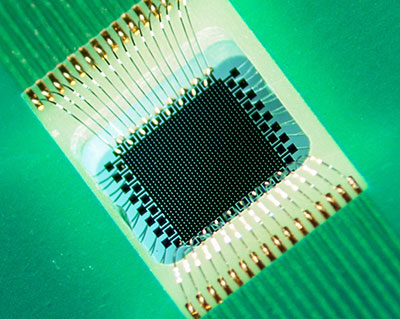Sensors
Diamond Detectors
For more than a decade, the Instrumentation Department has been developing high-performance diamond radiation detectors for a variety of applications, including proton beam flux monitoring and synchrotron x-ray imaging. The radiation hardness of diamond makes the detectors adept at measuring protons, alpha particles, and other charged particles for applications in medicine and nuclear nonproliferation. Because of diamond’s high charge-carrier saturation velocity, these detectors are also ideal for ultrafast (picosecond) detection in intense radiation environments.
Our Capabilities
- Fabrication of a range of diamond sizes, from standard (4.5 × 4.5 mm with a 20–500 μm thickness) to thin (5–10 μm)
- Demonstration of detectors with linearity-of-flux measurements over 11 orders of magnitude and a sub-picoampere leakage current
- Deposition of different metals via thermal processing, electron-beam evaporation, or sputtering
- Generation of ultra-nanocrystalline diamond (UNCD) electrical contacts via patterning
- Application of capabilities in our in-house High-Density Interconnect Laboratory (HDIL), printed circuit board design facility, and sensor packaging machining facility
Case Studies
Synchrotron Beam Position Monitors
Diamond x-ray beam position monitors installed at Brookhaven’s National Synchrotron Light Source II (NSLS-II), Argonne’s Advanced Photon Source, the Cornell High Energy Synchrotron Source (CHESS), and other synchrotrons around the world have a position resolution of 0.1% of the beam size down to <50 nm and are suitable for x-ray energies of 4keV and higher. Using the unique assembly and wire bonding capabilities of HDIL, we designed detectors to allow for novel nonmetallic contact materials such as UNCD, small contact geometries, and high-current devices. The UNCD contacts share many of the advantageous characteristics of the underlying diamond, such as radiation hardness and high transmission, and do not introduce x-ray absorption lines, which are undesirable for most spectroscopy experiments.
Real-time Beam Measurements
CHESS and NSLS-II have deployed transmission-mode diamond x-ray imaging detectors (60-micron pixel size) for real-time measurements of beam shape, position, and flux. For these detectors, we developed the electronics and diamond sensor, which takes advantage of the high dynamic range of diamond’s x-ray linearity.





